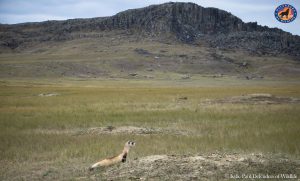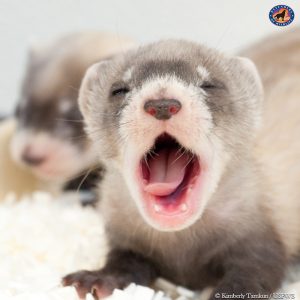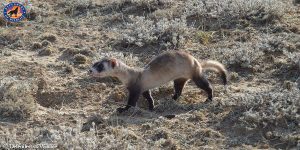National Ferret Day, celebrated April 2nd of each year, is also a day to recognize the importance of the domestic ferret’s wild counterpart, the black-footed ferret, a native species of the Great Plains. With its cream-colored silky fur and bandit-masked face, the endangered black-footed ferret is cute but rarely seen due to its nocturnal behavior.

This animal is really the star of a great comeback story! The black-footed ferret was thought extinct until 1981 when it was discovered on a Wyoming ranch by a dog named Shep. This led to a captive breeding and release program, led by the U.S. Fish and Wildlife Service, designed to restore the species to the wild.
The black-footed ferret is the focus of major conservation efforts on the ground today due to its endangered status. There are only about 500 animals in the wild, but successful recovery could one day mean ferrets can be downlisted to threatened and eventually delisted and removed from the Endangered Species List. The target is 1,500 breeding adults for downlisting and 3,000 breeding adults for delisting. But much work remains to bring back this native species to the prairie grasslands, where it has a long and valued natural history.

Defenders of Wildlife, over the last decade, in cooperation with state and federal wildlife agencies, has been instrumental in reintroducing and recovering black-footed ferrets. This species is quite different from the domestic ferret known as a pet. Did you know the black-footed ferret is a carnivore that relies solely on the prairie dog for its survival? One ferret can eat 100 prairie dogs per year. Not only do they eat prairie dogs, they also occupy the prairie dog burrows dug deep into the ground. Without prairie dog colonies, black-footed ferrets cannot survive.
The black-footed ferret is endangered in large part because of the more than 90 percent loss of prairie dogs. Over the last 100 years, prairie dog colonies across the West have been plowed and poisoned across vast areas. A new threat is the exotic disease plague, which arrived in North America in 1900 and can wipe out entire prairie dog colonies.
The loss of prairie dogs affects more than just black-footed ferrets. Prairie dogs are known as a “keystone species” that significantly contribute to the survival of many wildlife species. Many animals benefit from prairie dogs as their prey and the network of burrows they dig as their homes. Swift fox and grassland birds such as ferruginous hawks, mountain plovers and burrowing owls are just some of the species that rely on these prairie dog towns. These species and others have also declined in large part due to the loss of prairie dogs.

But hope is not lost! Conservation actions for prairie dogs are really making a difference for the successful recovery of the black-footed ferret. For example, protection and restoration of prairie dog colonies on some public, tribal and private lands is helping the ferret return to its historic range. Over 20 sites are now home to this endangered animal! Also, on-the-ground plague mitigation, supported by Defenders and many others, can help control the spread of plague on these important sites. National Ferret Day is a great day to celebrate this comeback story of the interconnected species of native wildlife on America’s grasslands.






